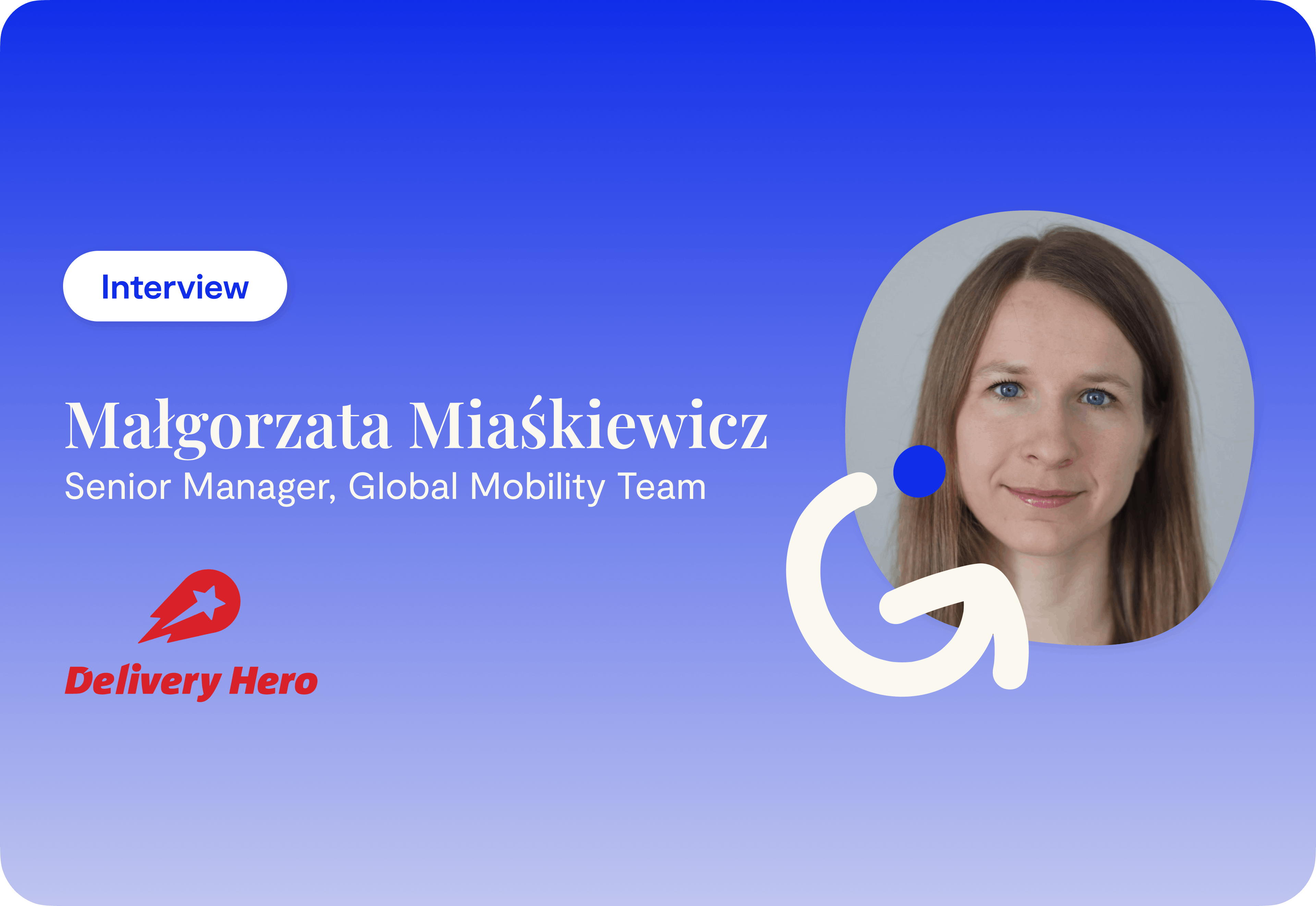From unexpected compliance risks to balancing in-house expertise with external vendors, Gosia shares how her team tackles the complexities of global mobility at DeliveryHero.
Managing global mobility is a complex challenge for enterprises, especially when navigating compliance across multiple regions. In this article, Małgorzata Miaśkiewicz (Gosia), Senior Manager in the Global Mobility team at DeliveryHero, shares her insights on the key risks, compliance challenges, and best practices in global mobility with Caroline, VP of Growth at Localyze.
Whether dealing with business travel turning into unintended assignments, handling immigration and tax conflicts, or managing vendors, Gosia provides a pragmatic approach to global mobility. Read on to discover how Gosia's team ensures compliance, balances internal and external support, and stays ahead of changing regulations - and get practical tips for your own global mobility efforts.
Q: To start, could you introduce yourself and tell us about your role?
Gosia: Sure! My name is Gosia. I’m a Senior Manager in the Global Mobility team at DeliveryHero. I’ve been here for four years, but I’ve been working in global mobility for more than a decade now. My role covers everything related to remote work for our Germany-based employees—from classic global mobility setups like assignments to handling situations where we hire someone in a country where we don’t have an entity. I also manage our international working program (workations). Basically, if there’s a global mobility process involving Germany and another country, I’m involved.
Q: What are some of the biggest compliance risks you deal with in global talent mobility, and how do you prioritize them?
Gosia: A good example is a business travel that turns into an assignment. People start traveling frequently, their scope increases, they become indispensable for the host entity and of course they need a different immigration support and compliance set up. When this happens, we have to jump in fast, start the work permit process, implement mitigation factors (like scope reduction) and make sure that the business is fully aware of what that means.
Another challenge is when immigration and tax laws conflict. Sometimes an employee becomes taxable in a country before their immigration status is sorted. That can trigger a whole chain reaction of compliance risks that aren’t easy to fix after the fact. We work with our providers to figure out pragmatic solutions that keep both the company and the employee protected.
Additionally, there’s the Posted Worker Directive. The notification for every country looks different, but there is one thing in common - it’s incredibly admin-heavy. We always give it a go to do it in-house but sometimes, it’s so complex that we have to outsource the process, which is expensive, but necessary.
Q: How do you ensure that your mobility programs stay compliant across different regions?
Gosia: Our foundation is a global mobility guideline that outlines compliance steps. That gives the business a concrete starting point. We cover and explain compliance topics that are not necessary top of mind for the business: immigration, corporate tax, wage tax, social security, employment law. We always prepare cost estimates for assignments to bring visibility and get proper cost approvals so that we can move forward with the right set up.
We also advice and share our knowledge with business partners and HR teams. Managing expectations is key—what works in one country doesn’t always apply in another.
Q: With regulations changing constantly, how does your team stay updated?
Gosia: It’s a mix of internal and external resources. First, we check with our local teams—sometimes they have the answer. If not, we reach out to external providers who specialize in immigration and tax.
We also maintain a database of country-specific regulations and subscribe to newsletters from multiple vendors. And when needed, we dig into official government sites.
Q: How do you decide what to outsource versus what to handle in-house?
Gosia: It depends. In Germany, we have very skilled legal and tax teams, so we handle a lot internally. But in smaller entities with limited HR or tax support, we might need external help.
We also benchmark with other global mobility professionals to compare vendors and pricing. Sometimes, we run RFPs to find the best solutions. If we don’t have the expertise or capacity in-house, outsourcing is the way to go.
Q: Are there any processes you always outsource?
Gosia: Yes—anything that requires deep local expertise, like immigration and tax filings. Some countries have incredibly complex regulations, and it’s just not worth our time to figure it out ourselves. It also depends on workload—if we’re overwhelmed, outsourcing keeps the workload manageable.
Q: How has that impacted your vendor strategy?
Gosia: We now work with more vendors and keep our options open. If we need to outsource something, we get quotes from multiple vendors and choose the best option. It’s all about flexibility.
Q: Internal education seems to be a big part of your strategy. How do you approach it?
Gosia: The key is to build relationships and being able to clearly communicate. We share knowledge with our HR business partners and managers so they can spot potential compliance risks before they become issues.
We turn our learnings into a case study and use it to educate the team. We also support other departments by sharing our vendor network.
Q: How do you balance global consistency with local flexibility?
Gosia: That’s an ongoing challenge. Right now, each brand within our company operates independently, but we’re working towards greater alignment. The goal is to have consistent policies and vendors across the board, but getting buy-in across different entities takes time.
Q: Why do you think global mobility often gets deprioritized?
Gosia: Because it’s complex! A lot of companies don’t think about it until something goes wrong. In Germany, where we have over 100 nationalities working together, global mobility is essential. But in other countries, where there’s less international movement, it’s not as much of a priority. As companies grow, though, they’ll start seeing the need for structured mobility programs.
Caroline: Thanks for sharing your insights, Gosia. This was really valuable.
Gosia: My pleasure! It was great talking with you.
Key Takeaways For Global Mobility Professionals
- Having clear global mobility guidelines and proactive training in those policies for managers and HR teams are essential to managing compliance effectively.
- Using external support to fill knowledge gaps and handle overflow work ensures efficiency while keeping workload manageable.
- Create case studies when things go wrong to provide relevant and actionable learning for teams.
- Flexibility in vendor strategy is key, including using RFPs and sharing vendor networks with other departments.
- Be your own champions. Global mobility is complex and that puts many enterprises off engaging with it - until something goes wrong.
By addressing these challenges head-on, companies can create a robust, compliant, and adaptable global mobility strategy.



